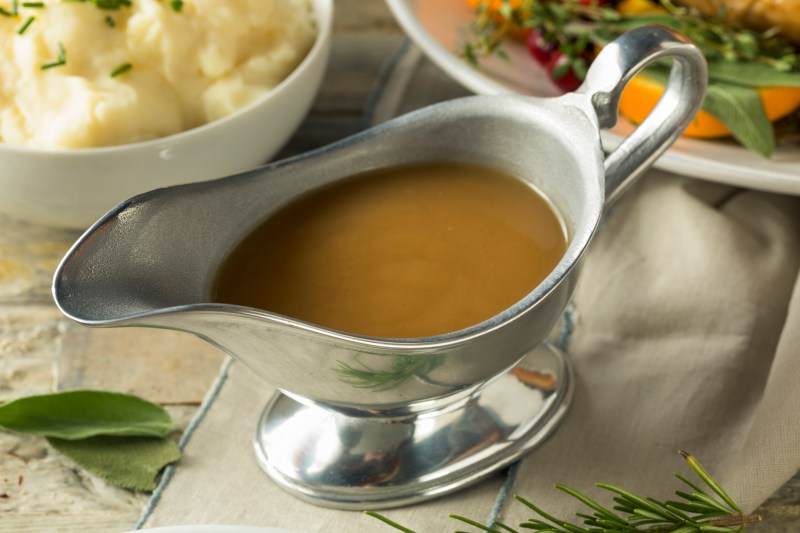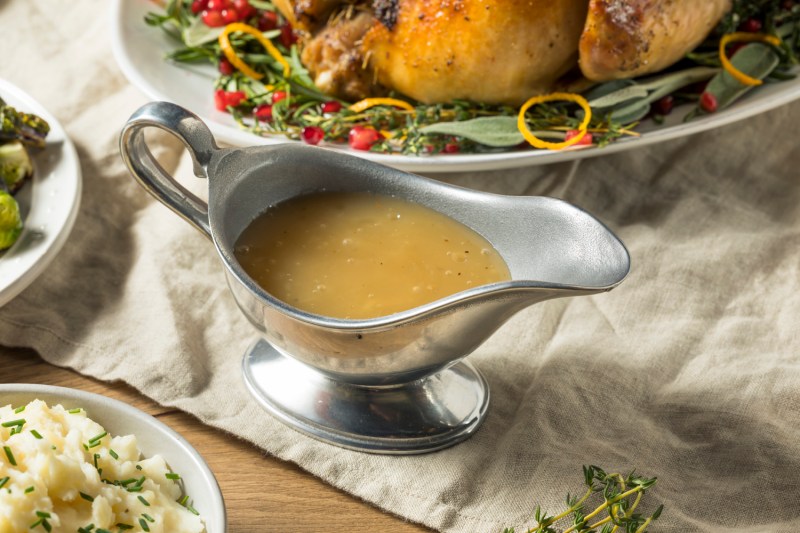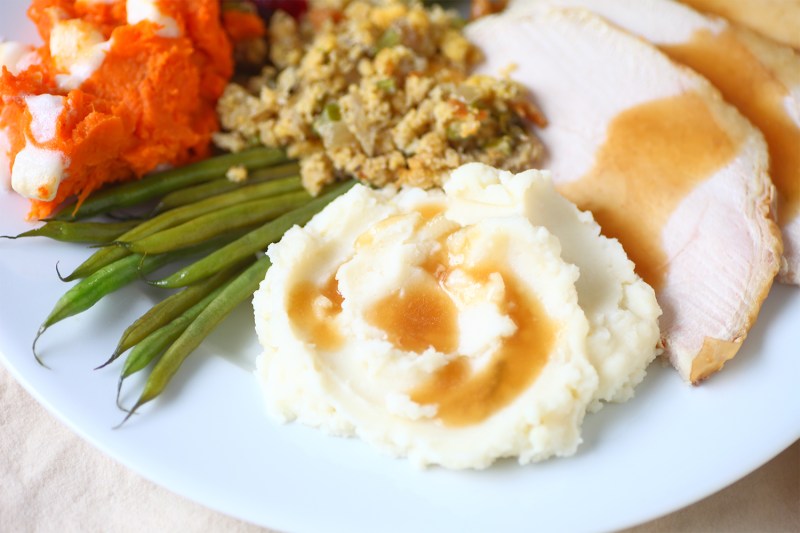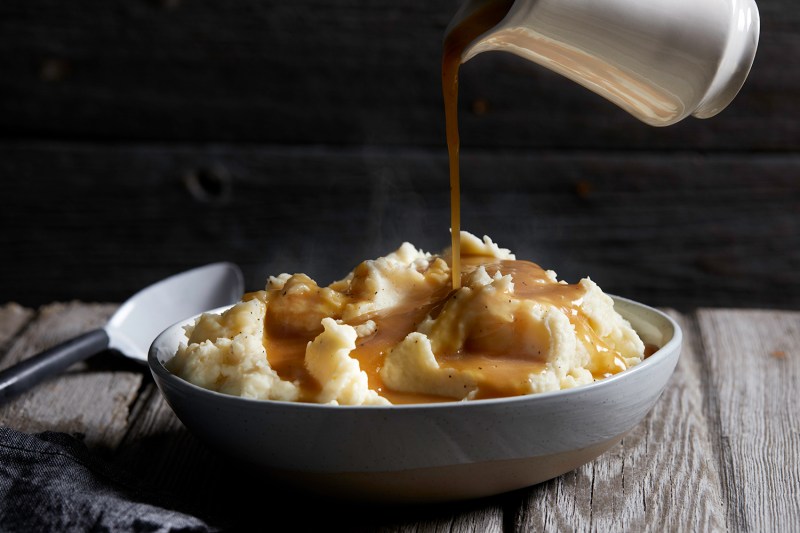The condiment of all condiments — Thanksgiving gravy. If you’re anything like me, this deliciously savory sauce is for so much more than just the turkey and mashed potatoes. Everything on my Thanksgiving plate tends to get an enormously generous slathering of gravy, and I’m pretty sure I’m not the only one.
But perfecting the art of Thanksgiving gravy can be a tricky task. The road is full of many potential pitfalls — drippy and runny consistency, starchy lumps, and lack of flavor. We’ve all experienced these little Thanksgiving turkey travesties and they’re heartbreaking. Gravy should be nothing short of velvety smooth, rich and savory,packed-with-flavor perfection. So let’s learn how to make that happen.
Turkey gravy tips and tricks

- For some reason, people are intimidated by making a roux. This is arguably the most flavorful and effective way to thicken a sauce or soup, and when you have it down, it’s an absolute breeze to make. The trick to getting it right every time is to use equal parts butter and flour and to make sure the butter is completely melted before adding in the flour. The longer you cook a roux, the more flavorful it will become; just be careful not to take it too far, or it may become bitter.
- Of course, the final flavor of your gravy will mostly depend on the flavors you’ve incorporated into your turkey. If you’ve used a lot of herbs and citrus, those will transfer beautifully to your gravy, so be sure to flavor your bird!
- Acid is your friend when it comes to gravy. There’s a reason citrus is one of the most commonly used ingredients when roasting poultry. It’s delicious. Be generous in adding lemon (or even grapefruit or orange) juice to your gravy for an added zip of flavor.
- Your roux should give you a velvety smooth gravy, but if you end up with lumps for some reason, worry not. You can simply strain your gravy through a fine-mesh sieve, and no one will be the wiser.
Turkey gravy recipe

Ingredients
- Drippings from your roasted turkey
- 3 cups chicken stock
- 4 tablespoons butter
- 4 tablespoons flour
- A few dashes of Worcestershire sauce
- Juice from one lemon
- Salt and pepper to taste
Method
-
Pour turkey drippings into a large measuring cup and set aside. When the fat rises to the top, spoon off most of it and discard. Add enough stock to the measuring cup to equal 4 cups of the stock/drippings combination.
- If the roasting pan you used for the turkey will fit on your stovetop, place it directly on the stove. If not, scrape all the leftover brown bits into a large saucepan and put that on the stove instead.
- Melt butter in the roasting pan or pot and add flour, stirring until a thick paste (roux) has formed. Cook the roux until it has browned.
- Add the drippings/stock mixture to the roux and whisk until well combined and thickened.
- Bring the gravy to a boil, then immediately reduce to a simmer, cooking until it reaches your desired consistency.
- While the gravy is simmering, add Worcestershire sauce, lemon, salt, and pepper.
- Serve warm and enjoy!
This Thanksgiving gravy recipe is delicious as is, but it also creates a perfect base for any additional flavors you want to incorporate. If your gravy could use a bit more flavor, look at what you used to season the turkey. Adding in some herbs and other ingredients will help your gravy shine.
If you’ve got vegetarians on your Thanksgiving dinner guest list, you can make a secondary gravy to fit their diet. Here’s an easy veggie Thanksgiving gravy recipe from Kitchen Treaty.
Easy vegetarian gravy (with onions)

Ingredients
- 5 tablespoons butter
- 1/2 cup finely diced yellow onion
- 1/4 cup all-purpose flour
- 2 cups low-sodium vegetable broth
- 1 tablespoon Tamari or soy sauce (optional)
- Salt and fresh ground black pepper to taste
Instructions
- Melt the butter in a medium saucepan over low heat.
- Add the onion and a pinch of salt. Sweat the onions, stirring occasionally, until they are tender, 8 to 10 minutes. Be sure to turn down the heat if they start to turn brown — you’re looking for translucent and tender onions, not golden.
- Increase the heat to medium and stir in the flour. Stir frequently for about 3 minutes while cooking.
- Gradually stir in the vegetable broth and continue stirring over medium heat. Cook and stir until the gravy is thickened, about 3 to 4 minutes.
- If you are adding this ingredient, stir in the Tamari or soy sauce. Add salt and pepper to taste, and serve.
Gluten-free turkey gravy recipe

If you’re having a big gathering at Thanksgiving, there’s a good chance that at least one of the people around your table will be on a gluten-free diet. Since most gravies are thickened with flour, that puts many gravy options off-limits for gluten-free people. Thankfully, there is a relatively simple solution. This easy gravy recipe from Gluten-Free on a Shoestring will allow everyone to enjoy slathering gravy all over their plate this Thanksgiving.
Ingredients:
- 4 tablespoons chopped unsalted butter
- 5 tablespoons superfine white rice flour
- 1 1/2 cups (12 fluid ounces) roasted turkey or chicken pan drippings, drained of the fat
- Fresh soup-style herbs like fresh sage leaves, fresh rosemary, fresh thyme, and/or fresh parsley to taste (optional)
- 2 1/2 cups (20 fluid ounces) low-sodium chicken stock
- Salt and pepper to taste
Method:
-
Melt the butter in a large, heavy-bottom skillet over medium heat.
-
Add the rice flour and whisk to combine. The mixture will clump.
-
Cook the mixture over medium heat, stirring frequently, until it’s golden brown and nutty smelling (about 3 minutes; pay close attention; it will darken quickly).
-
If using, add the pan drippings and herbs and combine. If your pan drippings have solidified, break them up and allow them to melt, whisking frequently.
-
Add 2 cups of the stock and mix to combine. Bring the mixture to a simmer over medium heat, and cook, stirring constantly, until thickened (2-3 minutes).
-
The mixture will thicken quickly. Strain the gravy into a large, heat-safe measuring cup to remove any solids. Stir in salt and pepper to taste.




